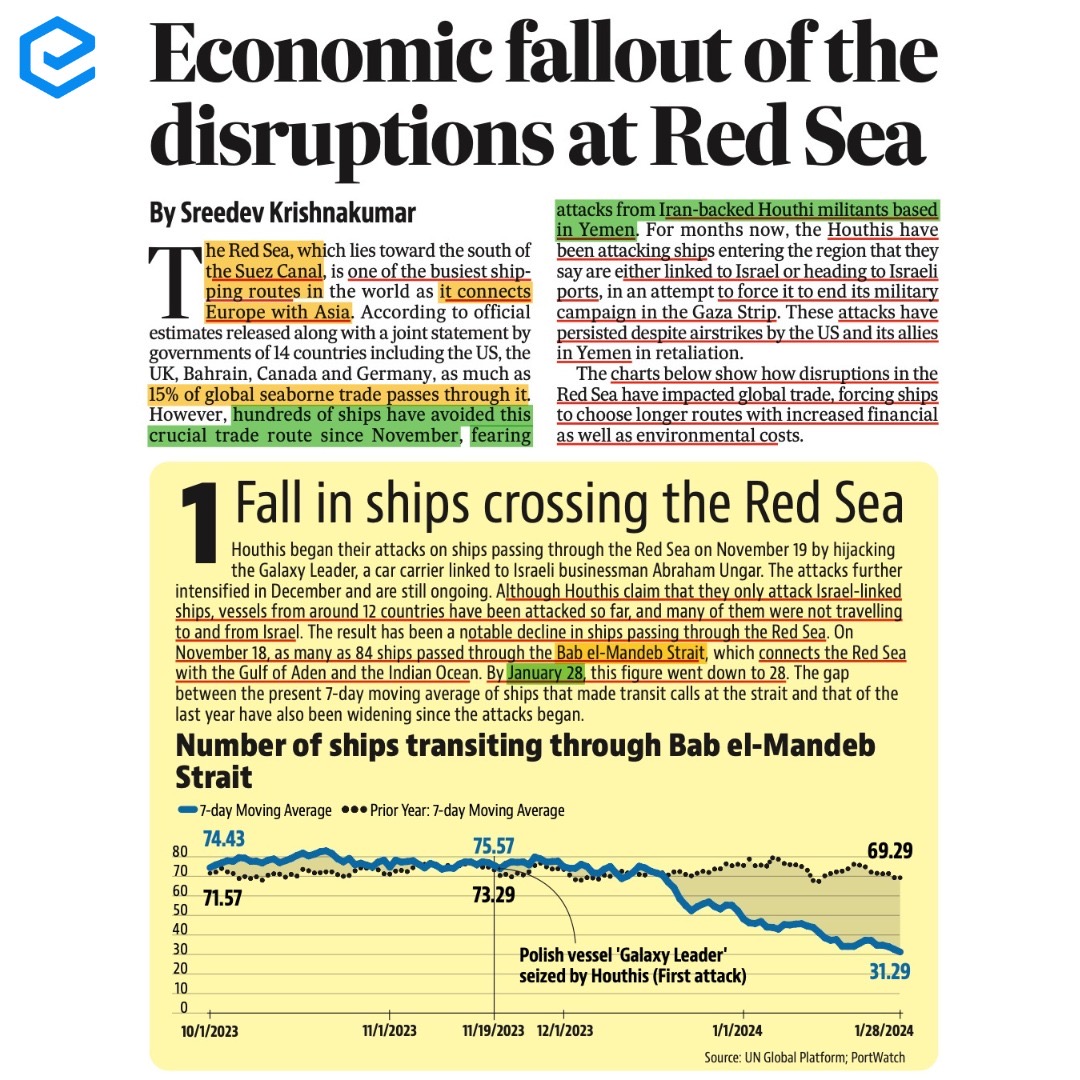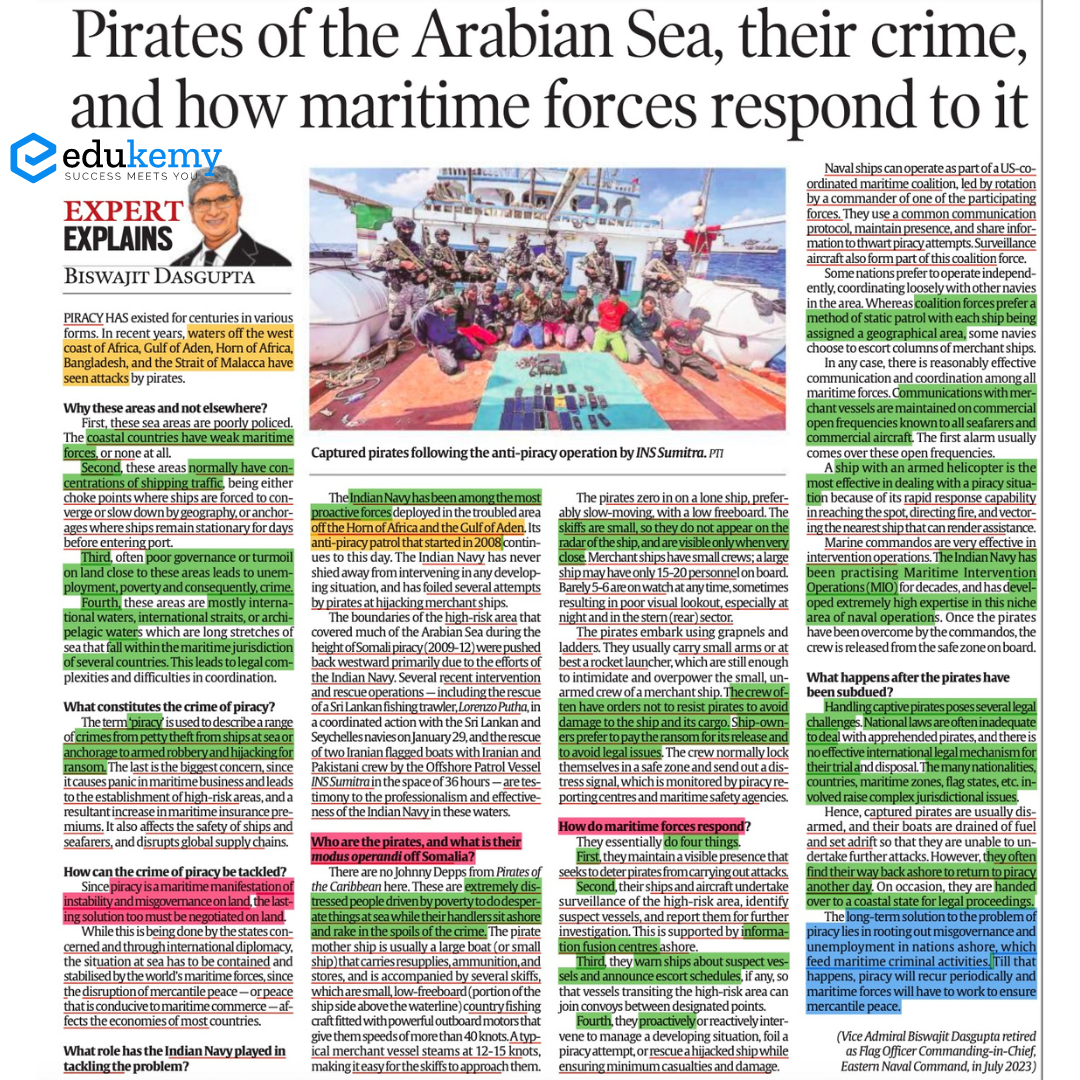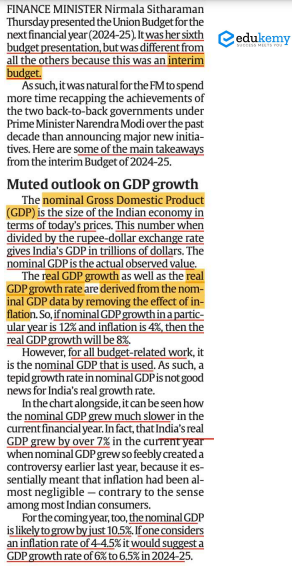Wednesday, 7th February 2024
Daily News Paper Snippets - 07th February 2024

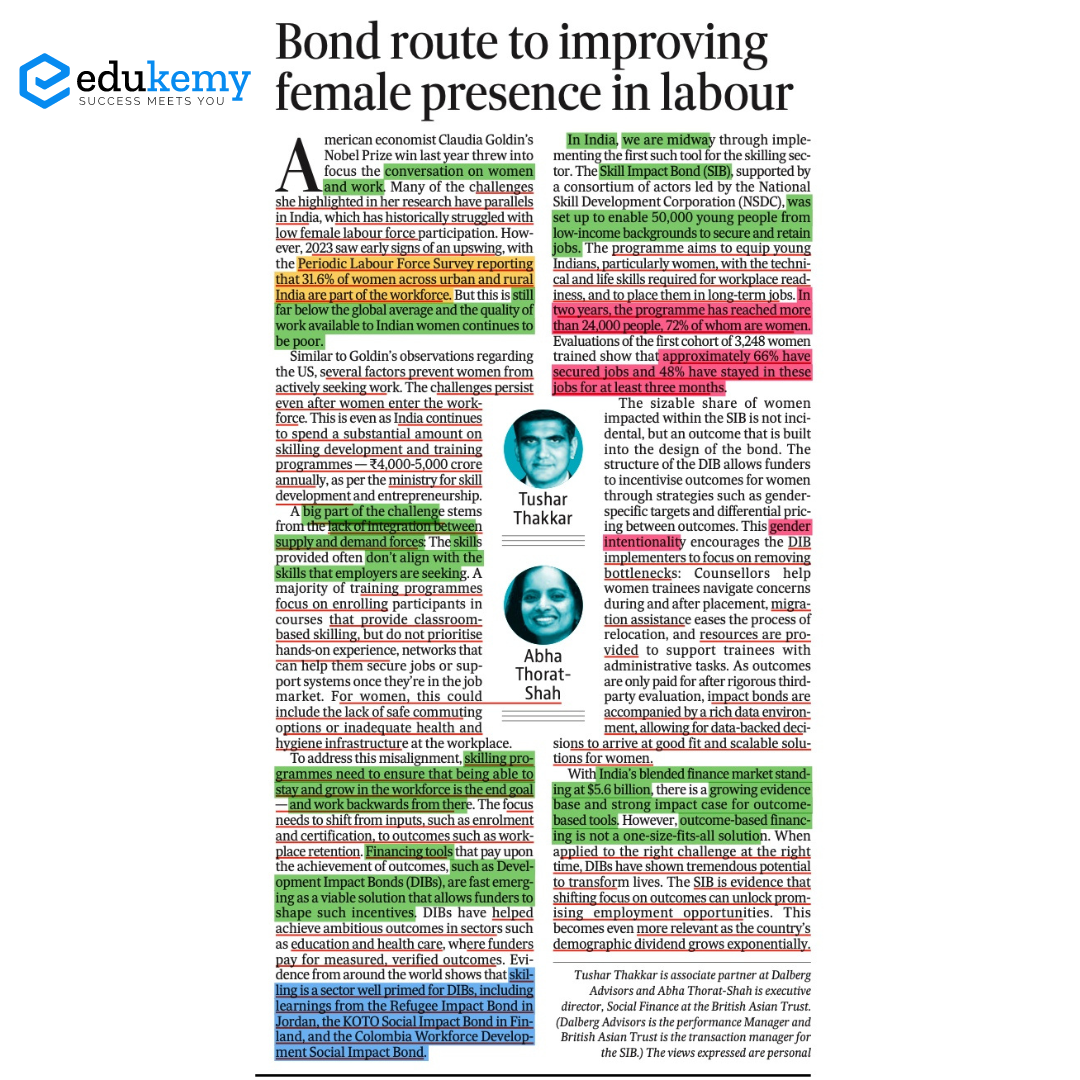
MEA's Development Aid
In News: The Interim Budget for the fiscal year 2024-25 has revealed the Ministry of External Affairs' (MEA) development assistance strategies, emphasizing a focus on strategic allies and neighboring nations.
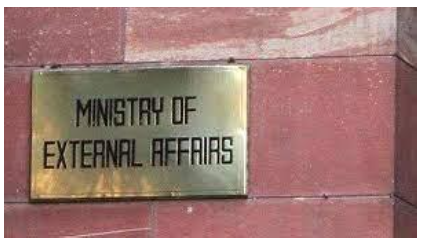
Distribution of Development Aid Among Countries
- The Interim Budget for the fiscal year 2024-25 reveals a total allocation of Rs 22,154 crore, an increase from the previous year's Rs 18,050 crore.
- Following the 'Neighbourhood First' policy, Bhutan receives the largest share of Rs 2,068 crore, emphasizing its importance as a key recipient.
- Maldives retains an aid allocation of Rs 600 crore, down from Rs 770 crore in the previous fiscal year.
- Afghanistan, maintaining India's special relationship, receives a budgetary aid of Rs 200 crore.
- Nepal is allocated Rs 700 crore, Bangladesh receives Rs 120 crore, Sri Lanka gets Rs 75 crore, Mauritius is granted Rs 370 crore, and Myanmar is earmarked for Rs 250 crore.
- African countries are allotted a separate fund of Rs 200 crore.
- Latin America and Eurasia, along with other regions, receive a combined development assistance of Rs 4,883 crore.
- The allocation for the Chabahar Port remains at Rs 100 crore, showcasing India's commitment to connectivity projects with Iran.
Other Development Partnerships of MEA
- Humanitarian Assistance
- MEA provides humanitarian aid during natural disasters, emergencies, and pandemics.
- India's extensive assistance during the Covid-19 pandemic includes relief supplies, medical teams, and financial aid to over 150 countries.
- Cultural and Heritage Cooperation
- MEA promotes cultural and heritage cooperation with over 50 completed projects, including the restoration of significant landmarks.
- Currently, around 25 cultural and heritage projects are in progress across various countries.
- Capacity Building and Technical Assistance
- India prioritizes capacity building through civilian and military training, on-site programs, and expert deputation.
- ITEC program spans 160 partner countries, offering diverse short-term training in areas like Engineering, Climate Change, Health, and Women Empowerment.
- Lines of Credit for Development Projects
- India extends concessional Lines of Credit (LOCs) under the IDEAS scheme, with 306 LOCs worth USD 30.59 billion to 65 countries.
- LOCs cover critical sectors like transport, power generation, agriculture, manufacturing, healthcare, education, and capacity building.
Importance of Bhutan for India
- Bhutan serves as a strategic buffer state between India and China, enhancing security.
- In the 2017 Doklam standoff, Bhutan played a crucial role by allowing Indian troops into its territory.
- India commits Rs. 45 billion to Bhutan's 12th Five Year Plan, focusing on Project Tied Assistance (PTA) for various sectors.
- Hydro-power cooperation is a key aspect, with operational projects and joint ventures contributing to Bhutan's socio-economic development.
- India and Bhutan share strong cultural ties, with India being Bhutan's top trade partner.
- Bhutan considers India as its holy land (gyagar) due to the shared cultural and religious history.
|
UPSC Previous Year Questions Mains (2016) Q. Evaluate the economic and strategic dimensions of India’s Look East Policy in the context of the post-Cold War international scenario. |
Source: IE
Resilient Growth in India's Manufacturing Sector
In News: MoSPI released the ASI for 2020-21 and 2021-22, revealing the organized manufacturing sector's pandemic impact on factories and fixed investments. Despite challenges, profits and invested capital experienced growth.
Overview of India's Manufacturing Sector
- Manufacturing stands as a vital driver of India's economic growth, with key sectors such as automotive, engineering, chemicals, pharmaceuticals, and consumer durables playing pivotal roles.
- Contributing approximately 17% to the nation's GDP and employing over 27.3 million workers, the manufacturing sector holds significant importance in the Indian economy.
Prospects for India's Manufacturing Sector
- India possesses both physical and digital infrastructure to elevate the manufacturing sector's share in the economy, aiming to be a key player in global supply chains.
- Government initiatives, guided by the National Manufacturing Policy, target achieving 25% of the economy's output from manufacturing by 2025.
- Key industries like electronics, industrial machinery, and textiles play crucial roles in India's ambition to reach a milestone of USD 1 trillion by 2028.
- Factors like power growth, long-term employment prospects, and skill development position India well for international market engagement.
Potential and Challenges
- India's manufacturing sector can leverage global value chains, utilizing advantages in raw materials, industrial expertise, and entrepreneurship.
- Opportunities lie in expanding exports, localizing imports, catering to internal demand, and engaging in contract manufacturing.
- The sector is gradually shifting towards more automated and process-driven manufacturing to enhance efficiency and production.
- Challenges include inadequate infrastructure, a shortage of skilled labor, a complex regulatory environment, and a need for innovation.
Navigating the Future
- Despite challenges, the manufacturing industry in India is moving towards self-reliance, marked by post-pandemic transformations.
- Efforts like Make in India, National Manufacturing Policy, and the PLI scheme for manufacturing contribute to India's progression toward Industry 4.0.
- India, already the world's fifth-largest economy, aims to become the third-largest by 2030, positioning itself as a global manufacturing hub.
- The Annual Survey of Industries (ASI) highlights positive trends, such as employment recovery, increased profits, and higher Gross Value Added, showcasing the resilience of the Indian manufacturing sector.
ASI Results Highlights
- Employment in the Manufacturing Sector
- Recovered post-lockdown, surpassing pre-pandemic levels in 2021-22.
- Recorded 2.1% CAGR growth in employment over two years.
- Fixed Capital Investments
- Experienced a sharp decline during the pandemic but showed marginal recovery in 2021-22.
- Gross fixed capital formation increased by about 5% from the pandemic-hit year of 2020-21.
- Profits in the Manufacturing Sector
- Witnessed substantial growth during the pandemic-affected years.
- Recorded a 42.3% CAGR increase, reaching Rs 9.51 lakh crore in 2021-22.
- Gross Value Added
- Significantly increased by 26.6% in 2021-22, driven by industrial output growth of over 35% in value terms.
- Significance of ASI Results
- The ASI results underscore the resilience and turnaround story of the Indian manufacturing sector, showcasing its ability to overcome challenges and adapt to changing circumstances.
Source: IE
Bill to Prevent Unfair Means in Public Examinations - 2024
In News: In the Lok Sabha, Union Minister Jitendra Singh presented the Public Examinations (Prevention of Unfair Means) Bill, 2024.
Introduction of the Public Examinations (Prevention of Unfair Means) Bill, 2024
Government's Response to Malpractices
- The Lok Sabha witnessed the introduction of the Public Examinations (Prevention of Unfair Means) Bill, aiming to curb malpractices and irregularities in competitive examinations.
Background and Need for the Bill
- Context: The bill arises in response to the cancellation of significant competitive tests, including teacher recruitment in Rajasthan and the Common Eligibility Test (CET) in Haryana, due to question paper leaks.
- Alarming Statistics: Reports indicate that over 1.5 crore students were affected by paper leaks from 2016 to 2023, with more than 70 cases of question paper leaks during this period.
- Recruitment Drive Impact: Paper leaks led to the cancellation of at least a dozen recruitment drives in various states between 2018 and February 2023.
Lack of Specific Legislation
- Current Scenario: The absence of a specific law to address unfair means in public examinations conducted by the central government and its agencies prompted the need for this legislation.
Key Provisions of the Public Examinations Bill
- Objective
- Clarity and Credibility: The bill aims to enhance transparency, fairness, and credibility in public examination systems, reassuring the youth that sincere efforts will be justly rewarded, securing their future.
- Applicability
- Covered Entities: The bill applies to central recruitment and entrance exams conducted by key authorities such as UPSC, SSC, RRBs, IBPS, and NTA.
- Extended Purview: All central ministries, departments, and their recruitment offices also fall under the scope of this legislation.
- Focus on Offenders, not Students
- Targeted Entities: The bill addresses persons, groups, or institutions involved in unfair means for financial or wrongful gains, excluding candidates appearing for exams.
- Administrative Provisions: Candidates continue to be governed by existing administrative provisions of the relevant public examination authority.
- Punishments and Fines
- Legal Consequences: The bill mandates three-to-five-year imprisonment for paper leak involvement, escalating to up to 10 years for organized crime links.
- Financial Penalties: A fine of Rs 1 crore and the recovery of examination costs from firms are specified, with the possibility of barring firms from conducting public exams upon conviction.
- Definition of Unfair Means and Nature of Offences
- Comprehensive Framework: Section 3 of the bill outlines 20 offences and unfair means, encompassing impersonation, answer sheet manipulation, and document tampering.
- Legal Status: Section 9 declares all offences as cognizable, non-bailable, and non-compoundable, ensuring a stringent legal stance.
- Investigation and Oversight
- Authority Structure: The bill suggests that officers not below the rank of deputy superintendent of police or assistant commissioner of police lead investigations.
- Central Agency Intervention: The government holds the power to transfer probes to a Central agency, granting autonomy to police actions without a warrant.
- National Technical Committee on Public Examinations
- Security Enhancement: The bill proposes a high-level national technical committee to recommend improvements in the computerized examination process.
- Focus Areas: The committee will address digital platform insulation, robust IT security systems, electronic surveillance at examination centers, and national standards for both IT and physical infrastructure.
- Model Draft for States
- Binding for Central Authorities: While binding for central public examination entities, the provisions serve as a model draft for states, ensuring consistency in addressing malpractices nationwide.
Source: FP
Renewables 2023 Report
In News: The Renewables 2023 report from the International Energy Agency (IEA) provides a nuanced portrayal of the renewable energy sector, showcasing advancements as well as confronting existing challenges.
Renewables 2023 Report: Key Highlights
- *Record Growth and China’s Dominance
- Global Surge in Renewable Capacity: Annual additions of renewable capacity reached nearly 510 GW in 2023, exhibiting the fastest growth rate in two decades.
- China's Pivotal Role: China led the way, commissioning solar PV equivalent to the entire world's 2022 capacity and experiencing a 66% year-on-year growth in wind additions.
- Global Power Mix Transformation
- Renewables Overtaking Coal: Projections indicate renewables surpassing coal as the primary source of electricity generation by 2025, with wind and solar PV dominating by 2028.
- Accelerated Growth in Key Regions
- US, EU, India, Brazil: Supportive policies drive rapid growth in solar PV and onshore wind installations.
- Middle East and North Africa: Policy incentives fuel renewable capacity growth, while sub-Saharan Africa lags behind.
- India's Growth Forecast: India is anticipated to add 205 GW from 2023-2028, doubling its 2022 cumulative installed capacity, positioning it as the third-largest global renewables market.
- Solar PV Market Dynamics
- Price Drop: Solar PV module prices decreased by almost 50% in 2023 due to increased manufacturing capacity.
- Competitive Advantage: Solar PV and onshore wind are economically superior to both new and existing fossil fuel plants, contributing to their widespread adoption.
- Biofuel Expansion and EV Adoption
- Emerging Economies Driving Biofuels: Led by Brazil, biofuel expansion is notable.
- Offsetting Oil Demand: Biofuels and renewable electricity in EVs are expected to offset substantial oil demand by 2028, underscoring their complementary role.
Major Challenges Highlighted
- Financial Constraints: Inadequate financing and rising interest rates pose challenges for renewable projects in emerging economies.
- Grid Bottlenecks: Rapid deployment of renewables faces integration challenges, leading to increased curtailment in various countries due to insufficient grid expansion.
- Wind Industry Challenges: Supply chain disruptions, especially in offshore wind, present hurdles for the wind industry.
Major Recommendations by IEA
- Triple Global Renewable Power Capacity: IEA urges governments to triple global renewable power capacity by 2030 in alignment with the Net Zero Emissions by 2050 (NZE) Scenario.
- Addressing Policy Uncertainties: To meet 2030 targets, IEA recommends addressing policy uncertainties, investing in grid infrastructure, easing administrative barriers, and enhancing financing in emerging economies.
International Energy Agency (IEA): Establishment, Evolution, and Focus
- Establishment and Evolution
- Origins in 1974: Established in response to the 1973-1974 oil crisis, initially focusing on oil supply security.
- Expanded Mandate: Over time, evolved to address a broader range of energy issues, with a mandate encompassing energy security, economic development, and environmental engagement worldwide.
- 2022 Mandate Expansion: Member governments expanded the mandate to guide countries toward building net-zero emission energy systems and include critical minerals and metals for clean energy technologies.
- Membership
- 31 Member Countries: IEA comprises 31 member countries and thirteen association countries, including India.
- Aspiring Members: Five countries seeking accession to full membership - Chile, Colombia, Israel, Latvia, and Costa Rica.
- OECD Membership Requirement: A candidate country must be a member of the OECD.
- Major Reports
- World Energy Outlook Report
- India Energy Outlook Report
- World Energy Investment Report
- Annual Energy Efficiency Market Report
|
UPSC Previous Year Questions Prelims () Q. Consider the following statements:
Which of the statements given above are correct? (a) 1, 2, 4 and 5 Ans: (b) Prelims (2016) Q.2 The term ‘Intended Nationally Determined Contributions’ is sometimes seen in the news in the context of (a) pledges made by the European countries to rehabilitate refugees from the war-affected Middle East (b) plan of action outlined by the countries of the world to combat climate change (c) capital contributed by the member countries in the establishment of the Asian Infrastructure Investment Bank (d) plan of action outlined by the countries of the world regarding Sustainable Development Goals Ans: (b) Mains (2020) Q. Describe the benefits of deriving electric energy from sunlight in contrast to conventional energy generation. What are the initiatives offered by our government for this purpose? Mains (2018) Q. “Access to affordable, reliable, sustainable and modern energy is the sine qua non to achieve Sustainable Development Goals (SDGs)”.Comment on the progress made in India in this regard. |
Source: IEA
Bharat Ratna to Lal Krishna Advani
In News: The government has recently declared that the esteemed leader Shri Lal Krishna Advani will be honored with Bharat Ratna, the highest civilian award in the nation.
About Lal Krishna Advani
- Serving as the 7th Deputy Prime Minister of India, he held office from 2002 to 2004.
- Additionally, he took on crucial roles as the Home Minister and Information and Broadcasting Minister during his tenure.
- Born in Karachi on November 8, 1927 (now in present-day Pakistan), he actively joined the Rashtriya Swayamsevak Sangh in 1942.
- Relocating from Sindh to Delhi in 1947 during the Partition, he continued his dedicated service.
- The Bharat Ratna, established in 1954, is bestowed in acknowledgment of exceptional service or performance of the highest order.
- Notably, this prestigious award recognizes achievements without any distinction based on race, occupation, position, or gender.
Source: IE
Vyommitra - Edukemy Current Affairs
In News: The Ministry of Science & Technology has revealed that the woman robot astronaut "Vyommitra" will precede the Indian Space Research Organisation's (ISRO) "Gaganyaan" mission.

About Vyommitra
- The "Vyommitra" Mission is set for the third quarter of 2024, while the manned mission "Gaganyaan" is scheduled for launch in 2025.
- Derived from Sanskrit, "Vyommitra" combines "Vyoma" (meaning Space) and "Mitra" (meaning Friend). This Female Robot Astronaut is equipped to monitor Module Parameters, issue Alerts, and perform Life Support operations.
- The Vyommitra Astronaut can operate six panels and respond to queries, simulating human functions in the space environment and interacting with the Life Support System.
- The Gaganyaan project's objective is to showcase human space capabilities by launching astronauts into a 400-kilometer orbit and safely bringing them back to Earth, with a planned landing in India's sea waters.
Source: PIB
India Energy Week 2024
In News: India's Prime Minister inaugurated India Energy Week (IEW) 2024 and the ONGC Sea Survival Centre in Goa. Additionally, he actively participated in the Viksit Bharat, Viksit Goa 2047 program.
About India Energy Week 2024
- India Energy Week 2024 is taking place in Goa from February 6th to 9th, serving as the country's largest and exclusive energy exhibition and conference.
- This event uniquely brings together the entire energy value chain, actively contributing to India's energy transition goals.
- IEW 2024 prioritizes the encouragement, fostering, and integration of startups within the energy value chain, highlighting their significant role.
- Emphasizing India's global standing, IEW underscores its position as the third-largest consumer of energy, oil, and Liquid Petroleum Gas (LPG). It also ranks as the fourth-largest importer and refiner of Liquefied Natural Gas (LNG).
- The event showcases India's dedication to global cooperation in the energy sector, emphasizing collaboration and knowledge sharing for sustainable energy development.
- The ONGC Sea Survival Centre, an Integrated Sea Survival Training Centre, aims to elevate India's sea survival training standards to a global level.
- Anticipated to train 10,000-15,000 personnel annually, the center places a strong emphasis on simulated exercises in challenging conditions, ensuring comprehensive training.
Source: PIB
Nagoya Protocol
In News: Cameroon has recently embraced the Nagoya Protocol on Access and Benefit Sharing.
About the Nagoya Protocol
- Objective and Adoption
- The Nagoya Protocol is a legally binding global agreement that enforces access and benefit-sharing obligations outlined in the Convention on Biological Diversity (CBD).
- Adopted in Nagoya, Japan, in October 2010, it came into force on October 12, 2014, following the deposit of the fiftieth instrument of ratification.
- Legal Framework
- Implements one of the CBD's objectives: ensuring fair and equitable sharing of benefits arising from the utilization of genetic resources.
- Provides a transparent legal framework for researchers and developers engaged in biotechnology research and development.
- Benefits
- Facilitates access to genetic resources for research activities in exchange for a fair share of benefits from their use.
- Offers a certainty to the research and development sector, encouraging investment in biodiversity-based research.
- Recognizes the value of traditional knowledge associated with genetic resources, ensuring indigenous and local communities receive benefits.
- Coverage
- Applies to genetic resources and associated traditional knowledge covered by the CBD.
- Encompasses benefits arising from the utilization of genetic resources and traditional knowledge.
Key Facts about the Convention on Biological Diversity (CBD)
- Comprehensive Agreement
- CBD, with 196 contracting parties, is the most comprehensive binding international agreement in nature conservation and sustainable natural resource use.
- Objectives
- Opened for signing in Rio de Janeiro in 1992, CBD has three primary objectives:
- Conservation of biological diversity (genetic, species, and habitat diversity).
- Sustainable use of biological diversity.
- Fair and equitable sharing of benefits from genetic resource utilization.
- Scope
- Covers biodiversity at all levels: ecosystems, species, and genetic resources.
- Decision-Making Body
- The Conference of the Parties (COP) is the highest political decision-making body of the CBD.
- Secretariat
- The Secretariat is based in Montreal, Canada.
- Binding Agreements
- Two internationally binding agreements support CBD objectives:
- Cartagena Protocol (2000): Regulates transboundary movement of living modified organisms (LMOs).
- Nagoya Protocol (2010): Establishes a legal framework for access to genetic resources and fair benefit-sharing.
Source: DTE
Messinian Event (Messinian Salinity Crisis - MSC)
In News: The Geological Institute of Israel has recently discovered an previously unknown underwater canyon near Cyprus, revealing its existence dating back to the Messinian Event.
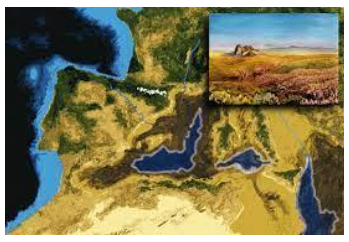
About the Messinian Event (Messinian Salinity Crisis - MSC)
- Definition
- The Messinian event, also known as the Messinian Salinity Crisis (MSC), was a significant geological occurrence where the Mediterranean Sea experienced partial or nearly complete desiccation (drying up).
- Ecological Impact
- Considered one of the most severe ecological crises in Earth's history.
- Timeline
- Initiated approximately 6 million years ago (MYA) and persisted until around 5.3 MYA.
- Causes
- The event began when the connection between the Atlantic Ocean and the Mediterranean Sea was severed.
- Lowered global sea levels and the collision of the European and African plates caused land uplift.
- Evaporation Process
- Normally, the Mediterranean experiences more evaporation than precipitation, resulting in a net water loss.
- Without a significant water source from the Atlantic Ocean, extensive evaporation occurred.
- Formation of Canyon
- A large underground canyon formed due to the desiccation process, surpassing the Grand Canyon in size, with depths up to 2,000 meters (6562 feet).
- Salt Deposition
- As water evaporated, salt deposits, including Halite and Gypsum, built up on the Mediterranean floor.
- Some salt deposit areas reached depths of 800 meters (2,500 feet).
- High Salinity Impact
- The remaining water became extremely salty, rendering the Mediterranean deadly to marine life.
- Completion of Desiccation
- The Mediterranean continued to dry up until almost no water remained.
- Zanclean Flood
- The event concluded with the Zanclean flood, where the Atlantic Ocean reclaimed the Mediterranean basin.
About Deep-sea Canyons
- Definition
- Deep-sea canyons are steep-sided valleys carved into the seafloor of the continental slope, often extending onto the continental shelf.
- Formation
- Vary in size, shape, and morphological complexity, formed through erosional processes such as mudslides, debris flows, and turbidity currents.
- Past Influence
- Some canyons were shaped by river flows during low sea level periods.
- Diverse Origin
- Canyons exhibit variability in their origin, with different processes contributing to their formation.
Source: TOI
Aldabra Giant Tortoise
In News: A project initiated six years ago, aiming to reintroduce giant tortoises to the wild in Madagascar, may lead to the repopulation of the island with thousands of megaherbivores for the first time in 600 years.
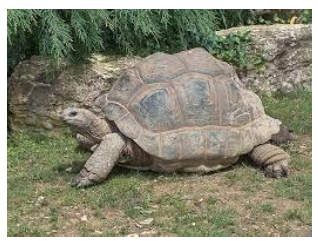
About the Aldabra Giant Tortoise
- Size and Ranking
- The Aldabra giant tortoise is the second-largest land tortoise species globally, following the Galapagos giant tortoise (Chelonoidis nigra).
- Lifespan
- Known for its impressive longevity, this species can live up to 100 years.
- Evolutionary History
- Evolved from the ancestors of Aldabrachelys abrupta, one of two giant tortoises that inhabited Madagascar for 15 million years.
- Migration to Seychelles
- Approximately four million years ago, the lineage of Aldabrachelys abrupta migrated to the Seychelles, potentially using drifting with floating vegetation and leveraging their natural buoyancy and swimming abilities.
- Endemism
- Endemic to the Aldabra Atoll in the Seychelles, situated about 930 miles east of Africa and northeast of Madagascar in the western Indian Ocean.
- Habitat Variety
- Terrestrial in nature, these tortoises inhabit diverse environments, including scrub forests, mangrove swamps, coastal dunes, and beaches, each characterized by specific vegetation.
- Dominant Populations
- Largest tortoise populations are found in grasslands known as "platins."
- Distinct Habitat - "Tortoise Turf"
- Prolonged grazing has led to the development of a unique habitat termed "tortoise turf," characterized by a variety of grasses.
- Conservation Status
- IUCN Classification: Vulnerable.
- CITES Listing: Appendix II.
- Geographical Context
- Indigenous to the Aldabra Atoll within the Seychelles archipelago.
Source: DTE
Reviving WTO's Credibility: Strategies for Restoring Authority
In News: The upcoming 13th ministerial meeting of the World Trade Organisation (WTO) in Abu Dhabi presents a new chance to tackle the persistent crisis within the Dispute Settlement Mechanism (DSM).
World Trade Organisation (WTO): Overview
- International Trade Oversight: WTO serves as an international institution regulating global trade rules among nations.
- Membership: Currently, WTO has 164 member countries and 25 observer countries, with Liberia and Afghanistan being the latest members since 2016.
- Inception: Officially commenced operations on January 1, 1995, replacing the General Agreement on Tariffs and Trade (GATT) from 1948.
WTO Organisational Structure
- Ministerial Conference: The highest authority, meeting biennially, consisting of all member states, with a focus on consensus in decision-making.
- Daily Operations: Handled by three bodies - General Council, Dispute Settlement Body (DSB), and Trade Policy Review Body.
Significance of the Appellate Body (AB)
- Binding Decision-Making: AB reviews and potentially overturns legal findings, ensuring definitive resolution in trade disputes.
- Compulsory Jurisdiction: AB's jurisdiction is compulsory for all WTO member countries, reinforcing a rules-based international trading system.
- Fair-Trade Practices: AB contributes to fair and equitable trade practices by enforcing compliance with WTO rules.
Current Challenges in the Dispute Settlement Mechanism (DSM)
- AB Crippling: AB's functionality hindered due to the U.S.' reluctance, impacting the binding nature of dispute resolution.
- Avoidance of Compliance: Countries exploit the AB's inoperability, evading compliance with WTO panel rulings.
- Delayed Dispute Resolution: Absence of a functioning AB leads to prolonged trade dispute resolutions, causing economic uncertainties.
- Threat to Rules-Based Trade: The DSM crisis undermines the concept of a rules-based international trading system.
Potential Solutions for Developing Countries
- Joining MPIA: Developing countries can consider joining the European Union-led MPIA for appellate review, albeit with certain downsides.
- Diluted AB with Limited Powers: Proposing a diluted AB with reduced powers to address U.S. concerns, risking the DSM's effectiveness.
- Resurrecting AB with Opt-Out Provision: Suggested resurrection of AB with an opt-out provision, allowing countries to opt out of compulsory jurisdiction, ensuring flexibility.
Conclusion
Navigating the crisis involves careful consideration, with the proposed AB resurrection providing a pragmatic compromise, balancing effectiveness and legitimacy in the international trade landscape.
Source: IE
Project Angan - Case Study of the Day
Project Angan in Chatra District aims to revitalize 40 Anganwadi Centres using District Mineral Funds, transforming them into child-friendly spaces with modern facilities, including Integrated Learning Materials, ICT-enabled teaching, BALA, and nutritious meals, fostering an engaging early education environment in remote areas.
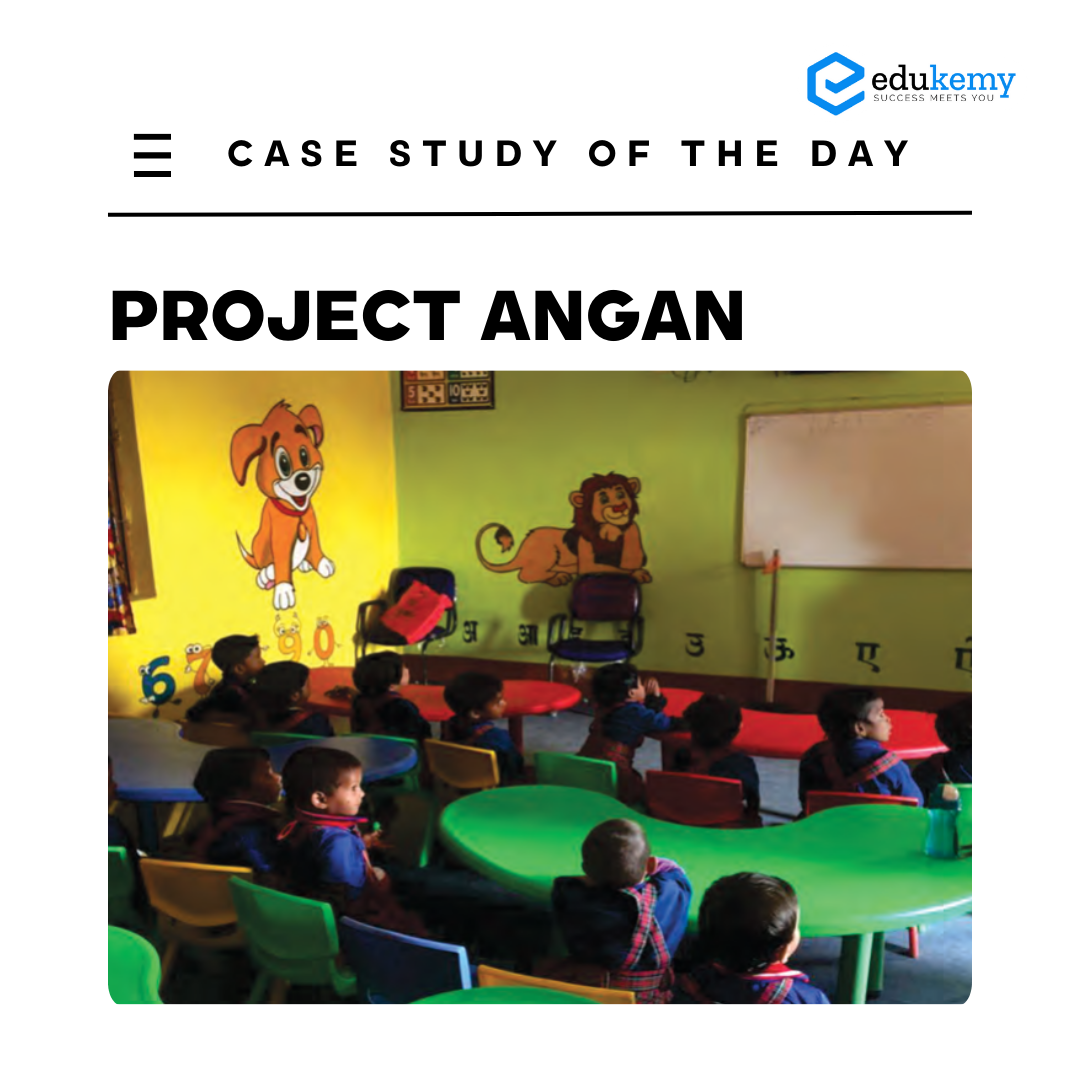
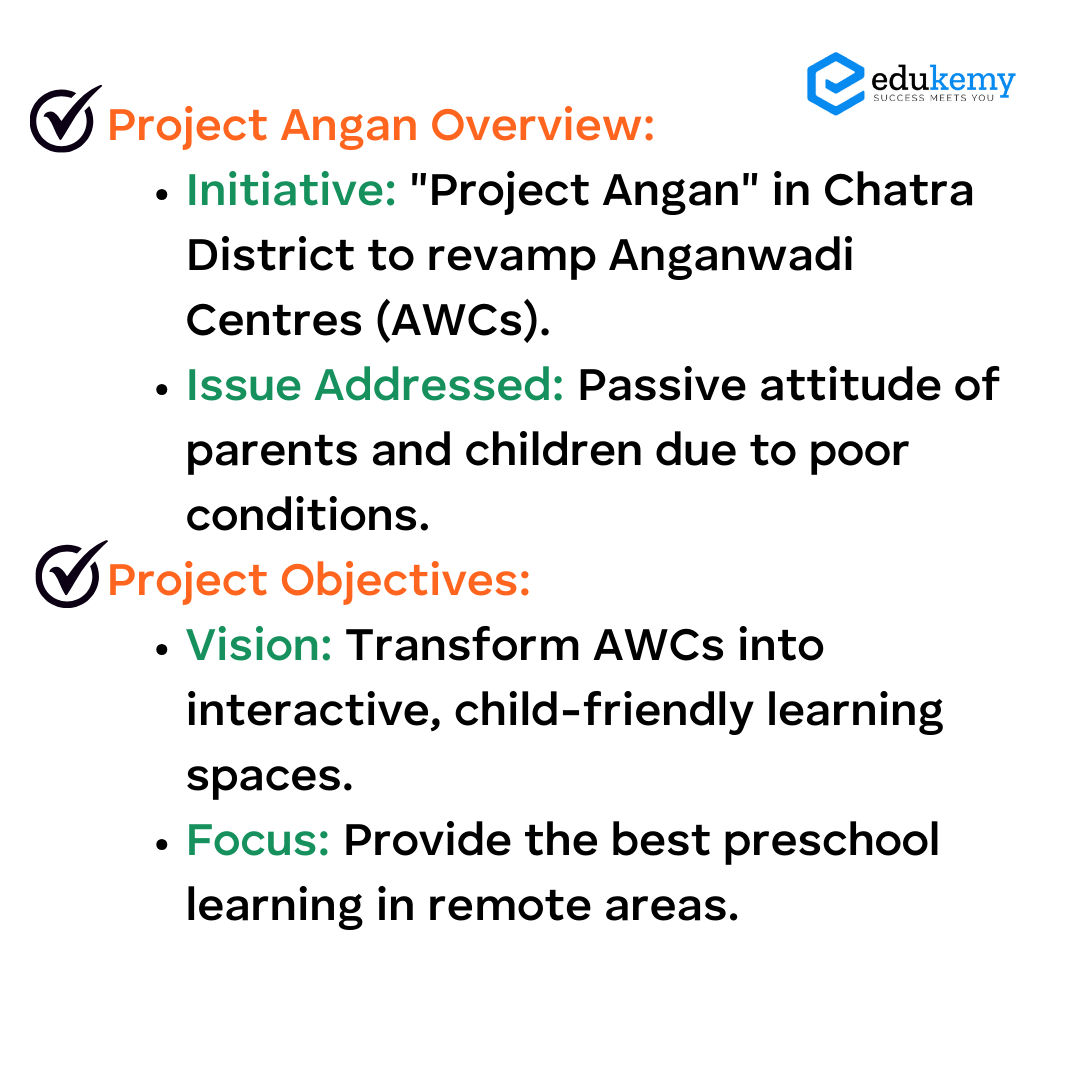
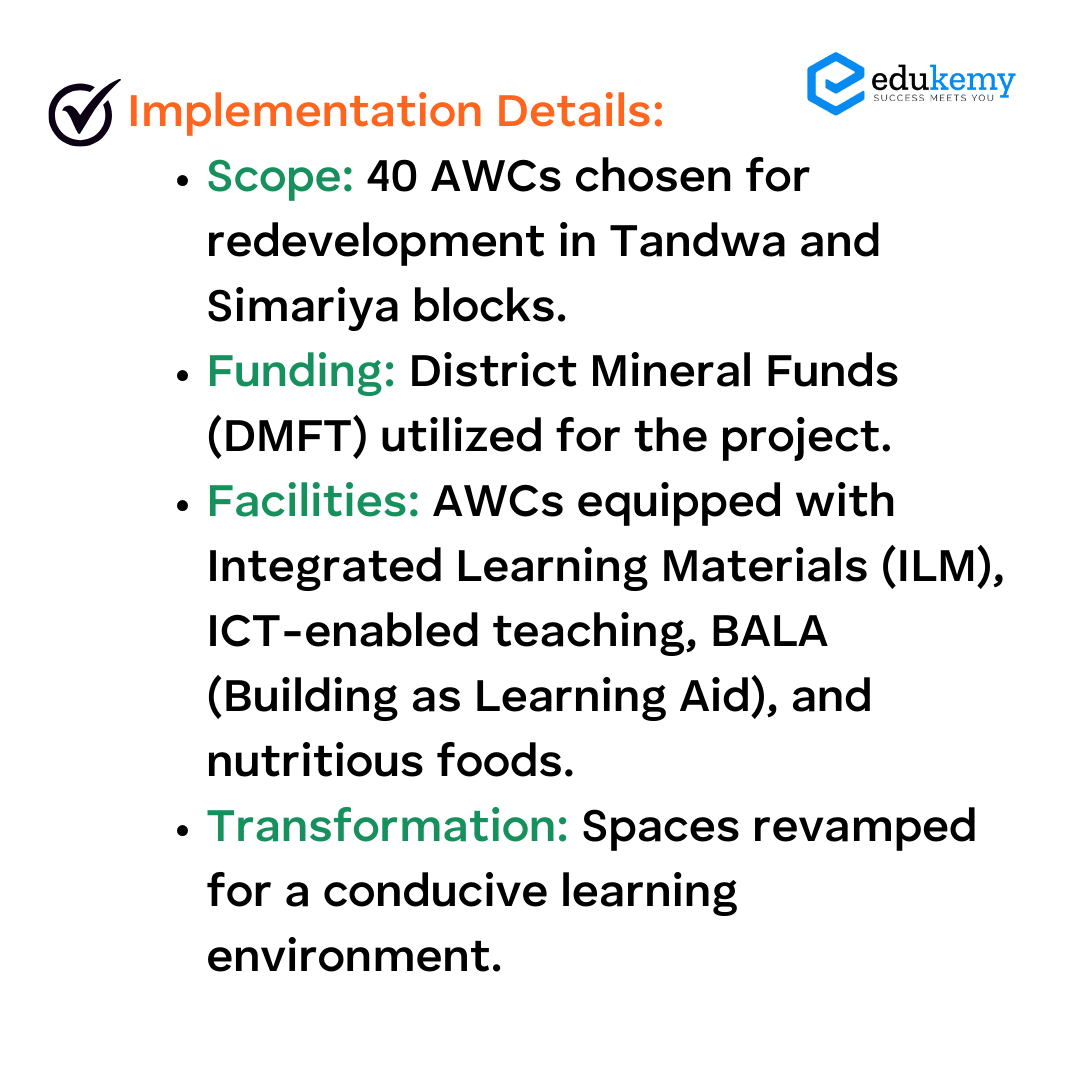
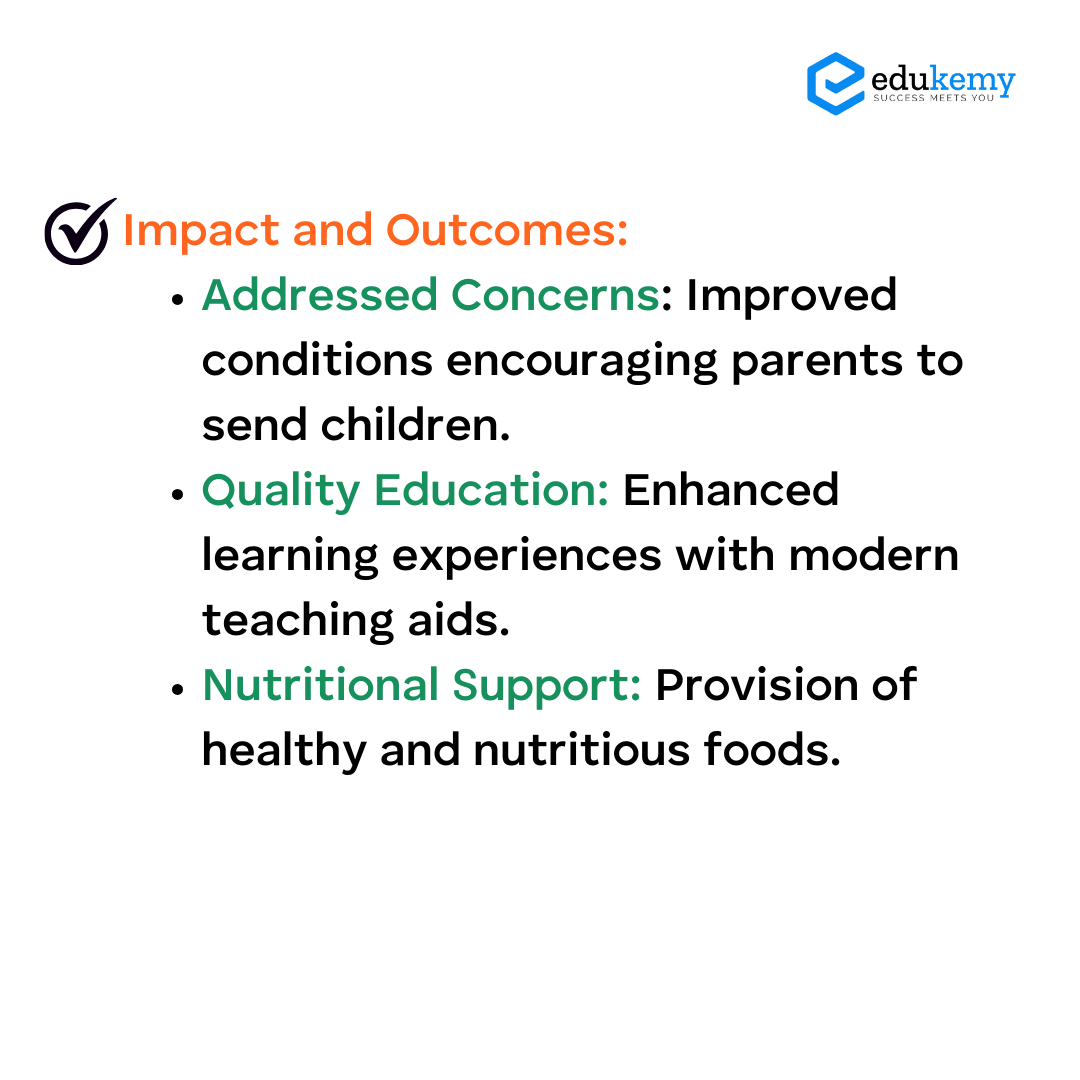
Share the article
Edukemy’s Current Affairs Quiz is published with multiple choice questions for UPSC exams
MCQ
Get Latest Updates on Offers, Event dates, and free Mentorship sessions.

Get in touch with our Expert Academic Counsellors 👋
FAQs
UPSC Daily Current Affairs focuses on learning current events on a daily basis. An aspirant needs to study regular and updated information about current events, news, and relevant topics that are important for UPSC aspirants. It covers national and international affairs, government policies, socio-economic issues, science and technology advancements, and more.
UPSC Daily Current Affairs provides aspirants with a concise and comprehensive overview of the latest happenings and developments across various fields. It helps aspirants stay updated with current affairs and provides them with valuable insights and analysis, which are essential for answering questions in the UPSC examinations. It enhances their knowledge, analytical skills, and ability to connect current affairs with the UPSC syllabus.
UPSC Daily Current Affairs covers a wide range of topics, including politics, economics, science and technology, environment, social issues, governance, international relations, and more. It offers news summaries, in-depth analyses, editorials, opinion pieces, and relevant study materials. It also provides practice questions and quizzes to help aspirants test their understanding of current affairs.
Edukemy's UPSC Daily Current Affairs can be accessed through:
- UPSC Daily Current Affairs can be accessed through Current Affairs tab at the top of the Main Page of Edukemy.
- Edukemy Mobile app: The Daily Current Affairs can also be access through Edukemy Mobile App.
- Social media: Follow Edukemy’s official social media accounts or pages that provide UPSC Daily Current Affairs updates, including Facebook, Twitter, or Telegram channels.


